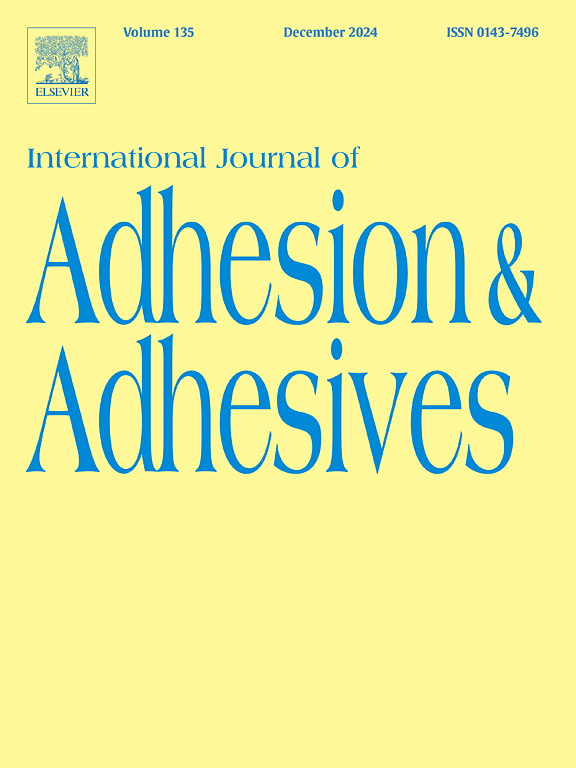Peel bond strengths of maxillofacial prosthetic silicone adhesives following exposure to tropical weather
IF 3.5
3区 材料科学
Q2 ENGINEERING, CHEMICAL
International Journal of Adhesion and Adhesives
Pub Date : 2025-06-30
DOI:10.1016/j.ijadhadh.2025.104095
引用次数: 0
Abstract
Objectives
The objective of this study was to compare the peel bond strength and modes of failure of maxillofacial prostheses (MFP) adhered to simulated human skin using regular adhesive and hydrobond adhesive following exposure to tropical outdoor weather.
Methods
Eighty MFP silicone specimens were constructed and adhered to simulated skin silicone using one of two maxillofacial prosthetic silicone adhesives (MFPSA): regular and hydrobond. For each adhesive, 20 samples were exposed to 4 h of tropical weather on five consecutive days (test group), and 20 samples were exposed to room temperature and dark room conditions for five consecutive days (control group). A T-peel test was conducted using a Universal Testing Machine and the samples were visually analyzed for mode of failure. Raman spectroscopic analysis was conducted with backscattering configuration.
Results
There were no significant differences in MFPSA peel bond strength between regular adhesive and hydrobond adhesives following five days of exposure to tropical weather. Within the tropical weather (test) group, hydrobond adhesive demonstrated similar peel bond strengths compared with the regular adhesive; p = 1.00 (Table 2). Within the room temperature and dark room conditions (control) group, hydrobond adhesive showed peel bond strengths significantly greater than the regular adhesive (p = 0.16). The mixed mode of failure involving both adhesive and cohesive failure was observed in 80 % of specimens.
Conclusions
The MFPSA peel bond strength was not affected by tropical weather conditions. Within the limitations of this in vitro study, the hydrobond adhesive demonstrated greater adhesive strength than the regular adhesive in room temperature and dark room conditions.
暴露在热带天气下的颌面假体硅树脂胶粘剂的剥离粘合强度
目的比较常规胶粘剂和氢键胶粘剂对颌面部假体(MFP)在模拟人体皮肤上的粘附强度和破坏模式。方法采用常规和氢键两种颌面假体硅胶胶粘剂(MFPSA)与模拟皮肤硅胶进行粘接。每种胶粘剂,20个样品连续5天暴露在热带天气下4小时(试验组),20个样品连续5天暴露在室温和暗室条件下(对照组)。使用通用试验机进行t型剥离试验,并对样品进行失效模式的视觉分析。采用后向散射结构进行拉曼光谱分析。结果常规胶粘剂与氢键胶粘剂在热带环境下暴露5天后,MFPSA剥离粘接强度无显著差异。在热带气候(试验)组中,与常规胶粘剂相比,氢键胶粘剂表现出相似的剥离粘结强度;p = 1.00(表2)。在室温和暗室条件下(对照组),氢键胶粘剂的剥离结合强度显著大于普通胶粘剂(p = 0.16)。在80%的试件中观察到粘着破坏和内聚破坏的混合破坏模式。结论MFPSA剥离粘结强度不受热带气候条件的影响。在体外研究的限制下,在室温和暗室条件下,氢键粘合剂比普通粘合剂表现出更高的粘合强度。
本文章由计算机程序翻译,如有差异,请以英文原文为准。
求助全文
约1分钟内获得全文
求助全文
来源期刊

International Journal of Adhesion and Adhesives
工程技术-材料科学:综合
CiteScore
6.90
自引率
8.80%
发文量
200
审稿时长
8.3 months
期刊介绍:
The International Journal of Adhesion and Adhesives draws together the many aspects of the science and technology of adhesive materials, from fundamental research and development work to industrial applications. Subject areas covered include: interfacial interactions, surface chemistry, methods of testing, accumulation of test data on physical and mechanical properties, environmental effects, new adhesive materials, sealants, design of bonded joints, and manufacturing technology.
 求助内容:
求助内容: 应助结果提醒方式:
应助结果提醒方式:


